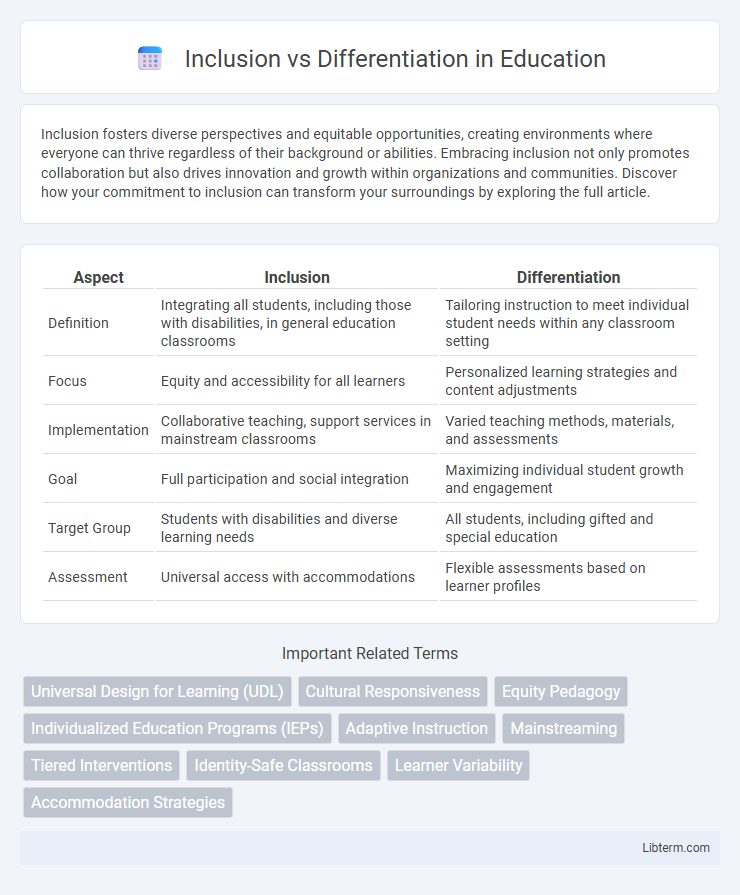Inclusion fosters diverse perspectives and equitable opportunities, creating environments where everyone can thrive regardless of their background or abilities. Embracing inclusion not only promotes collaboration but also drives innovation and growth within organizations and communities. Discover how your commitment to inclusion can transform your surroundings by exploring the full article.
Table of Comparison
| Aspect | Inclusion | Differentiation |
|---|---|---|
| Definition | Integrating all students, including those with disabilities, in general education classrooms | Tailoring instruction to meet individual student needs within any classroom setting |
| Focus | Equity and accessibility for all learners | Personalized learning strategies and content adjustments |
| Implementation | Collaborative teaching, support services in mainstream classrooms | Varied teaching methods, materials, and assessments |
| Goal | Full participation and social integration | Maximizing individual student growth and engagement |
| Target Group | Students with disabilities and diverse learning needs | All students, including gifted and special education |
| Assessment | Universal access with accommodations | Flexible assessments based on learner profiles |
Understanding Inclusion: A Comprehensive Overview
Inclusion emphasizes integrating all students, regardless of their abilities or backgrounds, into mainstream classrooms to promote equal access to education and social participation. It involves adapting teaching methods and learning environments to accommodate diverse needs, ensuring every student actively engages and benefits from the educational experience. Understanding inclusion requires recognizing its foundation in equity, collaboration among educators, and fostering a supportive community that values diversity and individual potential.
Differentiation Defined: Tailoring to Student Needs
Differentiation is an educational approach that customizes teaching methods, materials, and assessments to address the diverse learning styles, readiness levels, and interests of individual students. This strategy enhances student engagement and maximizes learning outcomes by providing targeted support and challenges that align with each learner's unique needs. Effective differentiation involves ongoing assessment, flexible grouping, and adaptive instruction to ensure all students achieve their full potential within inclusive classroom environments.
Core Principles of Inclusive Education
Inclusive education centers on providing equitable learning opportunities by embracing diversity and removing barriers to participation for all students, including those with disabilities. Core principles emphasize collaboration, respect for individual differences, and adapting teaching methods to meet diverse learner needs within a unified classroom environment. This approach fosters social integration, promotes equal access to quality education, and supports the holistic development of every student.
Differentiation Strategies in the Classroom
Differentiation strategies in the classroom involve tailoring instruction to meet diverse student needs by varying content, process, product, and learning environment based on learners' readiness, interests, and profiles. Techniques such as flexible grouping, tiered assignments, and ongoing assessment allow educators to provide personalized learning experiences that enhance engagement and academic growth. Effective differentiation fosters an inclusive atmosphere by recognizing individual strengths and challenges while promoting equitable access to knowledge.
Key Differences Between Inclusion and Differentiation
Inclusion emphasizes integrating all students, regardless of ability or background, into general education classrooms with appropriate supports, fostering a unified learning environment. Differentiation refers to tailoring instruction methods, content, and assessments to meet diverse learners' individual needs within the same classroom setting. Key differences lie in inclusion's focus on physical and social integration, while differentiation concentrates on customizing educational approaches to enhance each student's academic growth.
Benefits of Inclusion for Diverse Learners
Inclusion fosters a supportive learning environment where diverse learners engage collaboratively, improving social skills and academic outcomes. This approach promotes equity by providing access to the general curriculum with appropriate accommodations, reducing stigmatization and enhancing self-esteem. Research shows inclusive settings boost peer interactions and motivation, leading to higher achievement and better long-term success for students with varied learning needs.
Challenges Faced in Practicing Differentiation
Teachers face significant challenges in practicing differentiation, including managing diverse student readiness levels, interests, and learning profiles within a single classroom. Limited time and resources complicate creating tailored lesson plans that address individual needs while maintaining curriculum standards. Balancing clear assessment criteria and maintaining classroom cohesion often hinders effective implementation of differentiated instruction.
Integrating Inclusion and Differentiation: Best Practices
Integrating inclusion and differentiation in education involves tailoring instructional strategies to meet diverse student needs while fostering an equitable learning environment. Effective practices include utilizing flexible grouping, adaptive assessments, and culturally responsive teaching to address varied learning styles and abilities. Employing collaborative planning among educators ensures alignment of inclusive goals and differentiated instruction for maximizing student engagement and achievement.
Impact on Student Outcomes: Inclusion vs Differentiation
Inclusion fosters a collaborative learning environment where students with diverse abilities engage in the same curriculum, often enhancing social skills and overall academic achievement through peer interaction. Differentiation tailors instruction to individual learning needs, leading to improved comprehension and personal growth by addressing specific strengths and challenges. Both approaches positively impact student outcomes by promoting equity, but inclusion emphasizes community and shared experiences while differentiation targets personalized academic progress.
Future Trends in Inclusive and Differentiated Education
Future trends in inclusive and differentiated education emphasize personalized learning technologies that adapt to diverse student needs, fostering equity and engagement. Growing implementation of AI-driven tools enables educators to design tailored instructional strategies, enhancing accessibility for learners with disabilities and varying abilities. Data analytics and collaborative platforms further support dynamic differentiation, promoting inclusive environments where all students can thrive academically and socially.
Inclusion Infographic

 libterm.com
libterm.com